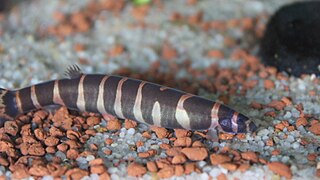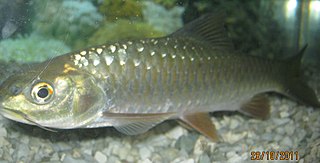
Tor is a genus of freshwater ray-finned fishes belonging to the family Cyprinidae, the family which includes the carps, barbs and related fishes. The fishes in this genus, and some related genera, are commonly known as mahseers. These fishes are found in Asia.

Mahseer is the common name used for the genera Tor, Neolissochilus, Naziritor and Parator in the family Cyprinidae (carps). The name is, however, more often restricted to members of the genus Tor. The range of these fish is from Vietnam in the east and China in the north, through Laos, Cambodia, Thailand, Malaysia, Brunei and Indonesia, and across southern Asia including the countries of India, Nepal, Bhutan and Bangladesh within the Indian Peninsula, plus Sri Lanka, Pakistan and Afghanistan. They are commercially important game fish, as well as highly esteemed food fish. Mahseer fetch high market price, and are potential candidate species for aquaculture. Several of the larger species have suffered severe declines, and are now considered threatened due to pollution, habitat loss, overfishing and increasing concern about the impacts of unregulated release of artificially bred stock of a very limited number of species.

Pangio is a genus of small Asian freshwater fish in the true loach family Cobitidae. In earlier taxonomic schemes it was known as Acanthophthalmus. The "kuhli loach" is well-known in the aquarium trade and commonly identified as P. kuhlii, but most individuals actually appear to be P. semicincta.

Neolissochilus is a genus of fish in the family Cyprinidae native to freshwater habitats in Asia that are often grouped with the mahseers. The largest reach up to 1.2 m (3.9 ft) in length, but most species are much smaller.

Cave research, encompassing the study of speleology and biospeleology, is still in its infancy in India. Although there are thousands of caves in India, research expeditions occur in few states. The Siju Cave in Meghalaya is the first limelighted natural cave from India. Several studies were carried out in this cave in the early 20th century. The Kotumsar Cave in Central India is one of the most explored caves of India, and biologists have classified many types of cavernicoles, i.e. trogloxenes, troglophiles and troglobites, from this cave.

Tor putitora, the Golden Mahseer, Putitor mahseer, or Himalayan mahseer, is an endangered species of cyprinid fish that is found in rapid streams, riverine pools, and lakes in the Himalayan region. Its native range is within the basins of the Indus, Ganges and Brahmaputra rivers. It was reported to be found in the Salween river, the natural border between Thailand and Myanmar as well, but the number is very rare, only three times in 28 years.

Cavefish or cave fish is a generic term for fresh and brackish water fish adapted to life in caves and other underground habitats. Related terms are subterranean fish, troglomorphic fish, troglobitic fish, stygobitic fish, phreatic fish, and hypogean fish.

Barbodes bovanicus, the Bowany barb, is a species of cyprinid fish native to the Cauvery River system in India. Its range is presently restricted to a single reservoir behind the Mettur Dam in Tamil Nadu. This species can reach a length of 36 centimetres (14 in) TL.

Neolissochilus wynaadensis, the Wayanad mahseer, is a species of cyprinid fish. It is endemic to the Wyanad Plateau and its surroundings in the southern Western Ghats, India. It occurs in fast-flowing rivers and streams with rock substrates. This species can reach a length of 50 centimetres (20 in) TL. It is of minor importance to local commercial fisheries.
Kryptoglanis shajii is a species of subterranean catfish found in subsurface waters in the Western Ghats in Kerala, India. This cavefish grows to a length of 5.9 centimetres (2.3 in) SL. It is currently the only known member of its genus and family. Although first discovered from underground waters, it has also been seen in dense vegetation in paddy fields and was found to be common in this habitat in the Chalakudy. The species strongly avoids light and feeds on small invertebrates.

Tor tor, commonly known as the tor mahseer or tor barb, is a species of cyprinid fish found in fast-flowing rivers and streams with rocky bottoms in India, Bangladesh, Bhutan, Nepal, and Pakistan. It is a commercially important food and game fish.
Tor sinensis, the Chinese or Red mahseer is a species of mahseer native to the Mekong River. It is known with certainty only from Yunnan, China; reports from Cambodia, Laos, and Thailand require confirmation.
It is one of four currently valid species described from China, the others being Tor laterivittatus, Tor polylepis, and Tor yingjiangensis.

The humpback mahseer is a species of freshwater ray-finned fish from the Indian endemic genus Hypselobarbus in the carp and minnow family Cyprinidae.

Tor remadevii, the orange-finned mahseer, also known as the hump-backed mahseer, is a Critically Endangered species of freshwater fish endemic to the Western Ghats of India. It is restricted to the Kaveri river basin.

Aenigmachanna gollum, the Gollum snakehead, is a species of aquifer-dwelling dragon snakehead fish that is endemic to the Indian state of Kerala.
Aenigmachanna is a genus of ray-finned fish in the order Ananbantiformes. It is the only genus in the family Aenigmachannidae, or dragon snakeheads. It contains two species, both of which are largely restricted to subterranean habitats in southwestern India, namely in the Western Ghats foothills in the state of Kerala.

Neolissochilus hexagonolepis, the copper mahseer, chocolate mahseer or katli, is a species of freshwater ray-finned fish belonging to the family Cyprinidae, the family which includes the carps, barbs and related fishes. This species is found in Nepal, eastern India, Bangladesh, Myanmar, Thailand, Malaysia and Sumatra. It may also be present in China and Viet Nam, also the record sof this species from the easyetn part of its range is uncertain and reports may be misidentifications.

Tor malabaricus, the Malabar mahseer, is a fish, a species of mahseer native to southwestern India.
Waikhomia hira is a species of freshwater ray-finned fish belonging to the belonging to the family Cyprinidae. the family which includes the carps, barbs and related fishes. This species is endemic to the Western Ghats of India.














